Life Regiment Grenadiers
Life Regiment Grenadiers (Swedish: Livregementets grenadjärer), also I 3, was a Swedish Army infantry unit that was active in various forms 1815–2000. The unit was based in Örebro Garrison in Örebro and belonged to the King's Life and Household Troops (Kungl. Maj:ts Liv- och Hustrupper) until 1974.[3][4][5]
| Life Regiment Grenadiers | |
|---|---|
| Livregementets grenadjärer | |
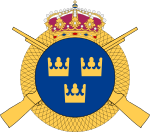 | |
| Active | 1815–2000 |
| Country | |
| Allegiance | Swedish Armed Forces |
| Branch | Swedish Army |
| Type | Infantry |
| Size | Regiment |
| Part of | 5th Military District (1833–1847) 4th Military District (1847–1893) 4th Army Division (1893–1901) IV Army Division (1902–1927) Eastern Army Division (1928–1936) IV Army Division (1937–1942) V Military Area (1942–1966) Bergslagen Military Area (1966–1991) Middle Military Area (1991–2000) |
| Garrison/HQ | Örebro |
| Motto(s) | Artibus et armis recuperatur gloria[note 1] |
| Colors | Light blue and white |
| March | "Livregementets grenadjärers marsch" (Eilhardt)[note 2] |
| Anniversaries | 4 December (Battle of Lund 1676) |
| Battle honours | Lützen (1632), Oldendorf (1633), Wittstock (1636), Leipzig (1642), Warsaw (1656), Frederiksodde (1657), Tåget över Bält (1658), Lund (1676), Landskrona (1677), Narva (1700), Düna (1701) Kliszów (1702), Fraustadt (1706), Holowczyn (1708), Malatitze (1708), Hälsingborg (1710), Gadebusch (1712), Svensksund (1790) |
| Insignia | |
| Branch insignia | .png) |
| Unit insignia | .jpg) |
Locations and training areas
Barracks
During the period that the regiment had its military camp at Utnäslöt, there was an office in Västerås. When the Life Regiment Grenadier Corps and Närke Regiment were amalgamated in 1893 and formed the Life Regiment of Foot, the greater part of the Life Regiment Grenadier Corps was transferred to Sannahed. From 1 October 1904, the regiment moved its office to Örebro, where it took over the former chancery building of the Life Regiment Hussars.[5] In 1913, the regiment left its military camp at Sannahed and moved into the barracks in Örebro on 2 March.[5] In Örebro, three barracks had been erected in connection with the neighborhood of Rynninge. The barracks were later (1958) named after three of the major victories of the Life Regiment Grenadier Corps and Närke-Värmland Regiment, respectively. Barracks 1 was named after Lund, Barracks 2 was named after Narva and Barracks 3 was named after Kliszów. The barracks along with the chancery building framed a large barracks yard in classic regiment architecture signed Viktor Bodin. Plans were in place to add a fourth barracks and with it form an open square around the barracks yard. The barracks establishment was erected after the 1901 Army Program following the Barracks Building Board's (Kasernbyggnadsnämnden) first series of type drawings. In total, some 80 buildings were erected in the area.[6] In connection with the barracks yard, the Swedish Missionary Society, through the association Soldaternas vänner i Örebro län ("Friends of the Soldiers in Örebro County") erected a so-called soldathem ("soldier's home") on Höglundagatan 2.
After the conscription training ended in the summer of 1992, the barracks yard was divided into an older and a younger section. The older southwest part of the barracks, among other things, was sold to Örebro Municipality. The younger northeast part consisting of, among other things, a hospital building, vehicle area, workshops and storage areas remained as a military area until 1999. Originally it was intended that the regimental staff would be grouped in the former hospital building. However, the staff remained in the chancery building and the Home Guard and volunteer sections of the regiment in their building in the southwest part. These two buildings were leased until the regiment was disbanded. After the Swedish Armed Forces left the northeast area in 2002, the area was developed into the neighborhood of Grenadjärstaden.[6]
- Chancery building
- Barracks 1 (Lund)
- Barracks 2 (Narva)
- Barracks 3 (Kliszów)
- Hospital
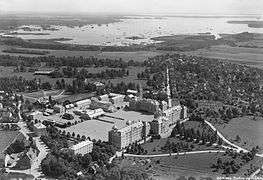 1939 aerial view
1939 aerial view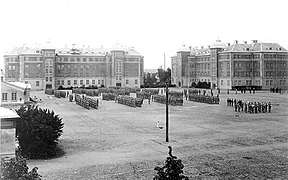 Barracks yard in 1928
Barracks yard in 1928
Training areas
When the Life Regiment was divided, the Life Regiment Grenadier Corps from 1780 came to have its military camp and training area at Utnäslöt just over 3 km northeast of Strömsholm Palace. The camp was left in 1894 (the last exercises were held there in 1893), but the place was maintained until 1902 as a remount depot. When the Life Regiment Grenadier Corps and Närke Regiment were amalgamated and formed the Life Regiment of Foot, Närke Regiment's military camp was taken over at Sannahed. There the regiment trained until 1912, after which the operations were transferred to Örebro. Sannahed came during World War II to act as an training area for the Landstormen as well as parts of the regiment's units that did not fit in Örebro.[5]
In 1944, the regiment added a new training area, Villingsberg, in Kilsbergen. The area was shared with the newly established Bergslagen Artillery Regiment (A 9)..[7]
 Memorial stone at Utnäslöt
Memorial stone at Utnäslöt- Buildings at Villingsberg
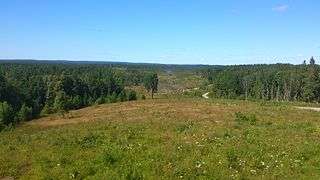 View of Villingsberg
View of Villingsberg
Heraldry and traditions
Colours, standards and guidons
The colour of the Life Regiment Grenadiers is drawn by Brita Grep and embroidered by hand in insertion technique by the company Libraria. The colour was presented to the regiment by His Majesty the King Gustaf VI Adolf on 12 December 1956. It was used as regimental colour by I 3/Fo 51 until 1 July 2000. Blazon: "On white cloth in the centre the Royal Swedish coat of arms as to the law without mantle. In each corner three yellow open crowns placed two and one. Battle honours (Lützen 1632, Oldendorf 1633, Wittstock 1636, Leipzig 1642, Warsaw 1656, Frederiksodde 1657, Tåget över Bält 1658, Lund 1676, Landskrona 1677, Narva 1700, Düna 1701, Kliszów 1702, Fraustadt 1706, Holowczyn 1708, Malatitze 1708, Hälsingborg 1710, Gadebusch 1712, Svensksund 1790) in yellow horizontally placed around the coat of arms."[8]
 Colour guard in 1997
Colour guard in 1997 Colour guard in 1967
Colour guard in 1967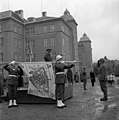 Colour guard in 1956
Colour guard in 1956
Coat of arms
The coat of arms of the unit was used from 1977 to 2000. Blazon: "Azure, the Swedish minor coat of arms, three open crowns or placed two and one. The shield surmounted two muskets in saltire and is surrounded by a roundel of straw placed under muskets and crown, all or."[9]
Medals
In 1937, the Örebro försvarsområdes och Livregementets grenadjärers förtjänstmedalj ("Örebro Defence District and Life Regiment Grenadiers Medal of Merit") in gold, silver and bronze (Fo51/I3GM/SM/BM) of the 8th size was established. In 1991, it was renamed Livregementets grenadjärers (I 3) förtjänstmedalj ("Life Regiment Grenadiers (I 3) Medal of Merit") in gold, silver and bronze (LivreggrenGM/SM/BM). The medal ribbon is of white moiré with pale blue edges and a pale blue stripe on the middle.[10]
In 2000, the Livregementets grenadjärers (I 3) minnesmedalj ("Life Regiment Grenadiers (I 3) Commemorative Medal") in silver (LivreggrenSMM) of the 8th size was established. The medal ribbon is of red moiré with a white stripe on the middle followed on both sides by a blue stripe.[11]
.jpg) Life Regiment Grenadiers (I 3) Commemorative Medal (obverse)
Life Regiment Grenadiers (I 3) Commemorative Medal (obverse).jpg) Life Regiment Grenadiers (I 3) Commemorative Medal (reverse)
Life Regiment Grenadiers (I 3) Commemorative Medal (reverse)
Commanding officers

Executive officers (Sekundchefer) and regimental commanders from 1815 to 2000. Sekundchef was a title used until 31 December 1974 in the regiments that were included in the King's Life and Household Troops (Kungl. Maj:ts Liv- och Hustrupper). From 1791 to 1809 the Crown Prince was regimental commander. From 1818 to 1974 His Majesty the King was regimental commander. From 1975 to 2000, the monarch was honorary commander of the regiment. However, Åke Hultin retained the title of Sekundchef until his departure in 1977.[12]
Regimental commanders
- 1815–1818: Crown Prince Charles John
- 1818–1844: Charles XIV John
- 1844–1859: Oscar I
- 1859–1872: Charles XV
- 1872–1905: Oscar II
- 1907–1950: Gustaf V
- 1950–1973: Gustaf VI Adolf
- 1973–1974: Carl XVI Gustaf
- 1975–1977: Åke Hultin
- 1977–1983: John Petersson
- 1983–1992: Einar Lyth
- 1992–1998: Hans Hacksell
- 1998–2000: Christer Svensson
Executive officers
- 1815–1821: C U Ridderstolpe
- 1821–1853: J E af Wetterstedt
- 1853–1861: N H Hägerflycht
- 1861–1865: O M von Knorring
- 1865–1875: H M Falkenberg
- 1875–1879: O E F Flemming
- 1879–1881: A H Leijonhufvud
- 1881–1884: H O E d'Ailly
- 1884–1893: C G von Ehrenheim
- 1893–1897: J F Lilliehök
- 1897–1902: Carl Axel Mauritz Nordenskjöld
- 1902–1911: Hugo Jungstedt
- 1911–1917: Hans Ludvig von Dardel
- 1917–1922: Carl August Pontus Axelsson Sjögren
- 1922–1927: Hugo Oskar Herman Wikner
- 1928–1931: Ernst Nils David af Sandeberg
- 1931–1936: Hugo Cederschiöld
- 1936–1937: Helge Jung
- 1936–1937: Axel Gyllenkrok (acting)
- 1937–1942: Manne Brandel
- 1942–1947: Alf Meyerhöffer
- 1947–1949: Engelbrekt Flodström (acting)
- 1949–1952: Engelbrekt Flodström
- 1952–1955: Carl Fredrik Lemmel
- 1955–1963: Per Wollrath Sebastian H:son Tamm
- 1963–1963: Sten Wåhlin
- 1964–1966: Ove Ljung
- 1966–1972: Ebbe Gyllenstierna
- 1972–1974: Erik Åke Hultin
Names, designations and locations
| Name | Translation | From | To | |
|---|---|---|---|---|
| Kungl. Livregementets grenadjärkår | Royal Life Regiment Grenadier Corps | 1815-12-16 | – | 1893-12-14 |
| Kungl. Livregementet till fot | Royal Life Regiment of Foot | 1893-12-15 | – | 1904-12-07 |
| Kungl. Livregementet grenadjärer | Royal Life Regiment Grenadiers | 1904-12-08 | – | 1974-12-31 |
| Livregementets grenadjärer | Life Regiment Grenadiers | 1975-01-01 | – | 2000-06-30 |
| Avvecklingsorganisation Örebro | Decommissioning Organisation Örebro | 2000-07-01 | – | 2000-12-31 |
| Designation | From | To | ||
| No. 3 | 1816-10-01 | – | 1914-09-30 | |
| I 3 | 1914-10-01 | – | 1975-06-30 | |
| I 3/Fo 51 | 1975-07-01 | – | 1992-06-30 | |
| Fo 51 | 1992-07-01 | – | 1994-06-30 | |
| I 3/Fo 51 | 1994-07-01 | – | 2000-06-30 | |
| Ao Öre | 2000-07-01 | – | 2000-12-31 | |
| Location | From | To | ||
| Örebro Garrison | 1904-10-01 | – | 2000-12-31 | |
See also
Footnotes
- In 1957, the Chief of the Army acknowledged that this motto, originally used by Närke-Värmland Regiment on a colour from 1658, was allowed to be used by the regiment.[1]
- The march was adopted in 1893 and established in 1953 by Army Order 33/1953. The march was used by the Livregementets grenadjärgrupp from 2000 to 2005, and of the Örebro-Värmlandsgruppen since 2005.[2]
References
Notes
- Handbok: parad 6: traditionsvård 2017, p. 48
- Sandberg 2007, p. 27
- Braunstein 2003, pp. 31–34
- Kjellander 2003, pp. 288–289
- Holmberg 1993, p. 8
- Berg 2004, p. 158
- Lyth & Gustavsson 1993, p. 202
- Braunstein 2004, p. 84
- Braunstein 2006, p. 21
- Braunstein 2007, p. 80
- Braunstein 2007, p. 110
- Kjellander 2003, pp. 282–284
Print
- Berg, Ejnar (2004). Vyer från kastaler, kastell och kaserner: guide över Sveriges militära byggnader : illustrerad med vykort (in Swedish). Stockholm: Probus. ISBN 9187184753. SELIBR 9818451.CS1 maint: ref=harv (link)
- Braunstein, Christian (2003). Sveriges arméförband under 1900-talet. Skrift / Statens försvarshistoriska museer, 1101-7023 ; 5 (in Swedish). Stockholm: Statens försvarshistoriska museer. ISBN 91-971584-4-5. SELIBR 8902928.CS1 maint: ref=harv (link)
- Braunstein, Christian (2004). Svenska försvarsmaktens fälttecken efter millennieskiftet [The flags and standards of the Swedish Armed Forces after the turn of the millennium] (PDF). Skrift / Statens försvarshistoriska museer, 1101-7023 ; 7 [dvs 8] (in Swedish). Stockholm: Statens försvarshistoriska museer. ISBN 91-971584-7-X. SELIBR 9815350.CS1 maint: ref=harv (link)
- Braunstein, Christian (2006). Heraldiska vapen inom det svenska försvaret [Heraldry of the Swedish Armed Forces] (PDF). Skrift / Statens försvarshistoriska museer, 1101-7023 ; 9 (in Swedish). Stockholm: Statens försvarshistoriska museer. ISBN 91-971584-9-6. SELIBR 10099224.CS1 maint: ref=harv (link)
- Braunstein, Christian (2007). Utmärkelsetecken på militära uniformer [Decorations on Swedish military uniforms] (PDF). Skrift / Statens försvarshistoriska museer, 1101-7023 ; 12 (in Swedish). Stockholm: Statens försvarshistoriska museer. ISBN 978-91-976220-2-8. SELIBR 10423295.CS1 maint: ref=harv (link)
- Holmberg, Björn (1993). Arméns regementen, skolor och staber: [en uppslagsbok] : en sammanställning (in Swedish). Arvidsjaur: Svenskt militärhistoriskt bibliotek (SMB). ISBN 91-972209-0-6. SELIBR 7796532.CS1 maint: ref=harv (link)
- Kjellander, Rune (2003). Sveriges regementschefer 1700-2000: chefsbiografier och förbandsöversikter (in Swedish). Stockholm: Probus. ISBN 91-87184-74-5. SELIBR 8981272.CS1 maint: ref=harv (link)
- Lyth, Einar; Gustavsson, Bengt, eds. (1993). Försvar i Örebro län: 1900-talet. Närkes militärhistoria, 99-0884938-7 ; 3 (in Swedish). Örebro: Stift. Nerikes regementen. ISBN 9163017776. SELIBR 7449440.CS1 maint: ref=harv (link)
- Sandberg, Bo (2007). Försvarets marscher och signaler förr och nu: marscher antagna av svenska militära förband, skolor och staber samt igenkännings-, tjänstgörings- och exercissignaler (in Swedish) (New ed.). Stockholm: Militärmusiksamfundet med Svenskt marscharkiv. ISBN 978-91-631-8699-8. SELIBR 10413065.CS1 maint: ref=harv (link)
- Handbok: parad 6: traditionsvård : H PARAD 6 2016 (PDF) (in Swedish). Stockholm: Försvarsmakten. 2017. SELIBR 22459606.
Further reading
| Wikimedia Commons has media related to Life Regiment Grenadiers. |
- Ardefors, Johan; Lyth, Einar (2012). Bielkemässen: officersmässen vid Livregementets grenadjärer i Örebro 1912-2006 (in Swedish). Örebro: Livregementets grenadjärers officerskår. ISBN 9789163705458. SELIBR 13987548.
- Forsman, Jonas; Westlund, Morgan; Werge, Henrik (1990). Ära, mod och högantenner: bilder från I3/Fo 51 Örebro : [ett brigadstabskompani i närbild] (in Swedish). [Örebro]: [M. Westlund]. ISBN 916300190X. SELIBR 7448347.
- Jonsson, Ulla-Britt (1992). Regementet I 3 Örebro 1991 (in Swedish) (1st ed.). [Örebro]: [U.-B. Jonsson]. ISBN 9163010593. SELIBR 7448949.
- Lilja, Lars (2013). Närkes krigsmannaminne D. 1 Biografiska anteckningar rörande officerare och likställda vid Närkes regemente 1812-1892. Närkes militärhistoria, 99-0884938-7 ; 4 (in Swedish). Örebro: Stiftelsen Nerikes regementen. ISBN 9789163722974. SELIBR 13941273.
- Lyth, Einar; Lannerbäck, Alf (2007). Klart bakåt!: livet i fält (in Swedish). Stockholm: Svenskt militärhistoriskt bibliotek. ISBN 9789185789108. SELIBR 10645008.
- Petersens, Magnus af, ed. (1967). Livregementets historia (in Swedish). Kumla: [Livregementet]. SELIBR 868709.
- Rosengren, Erik, ed. (1948). I fält 1939-1945: närkingar och bergslagsfolk under beredskapen (in Swedish). [Örebro]: [s.n.] SELIBR 1408340.
- Tapper, Tage (1967). Den gamla officersmässen: anteckningar vid återinvigningen av officersmässen vid Sannahed den 27 augusti 1967 (in Swedish). Kumla: [Dohlwitz bokh.] SELIBR 2068353.